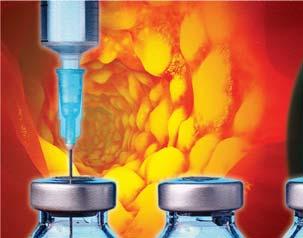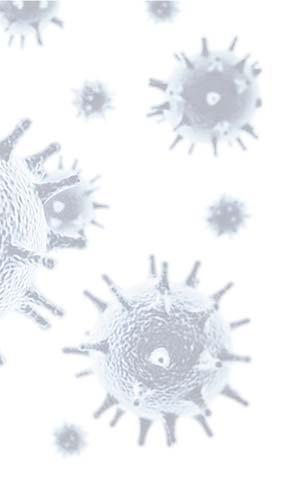
6 minute read
A $500K windfall from biosimilars
A Windfall in Savings From Biosimilars
Transitioning patients taking infliximab to a biosimilar product and improving adherence to imatinib are among the strategies specialty pharmacists at Boston Medical Center Health System (BMC) used to help the system better use health care resources, according to a session at the 2020 NASP Annual Meeting & Expo Virtual Experience.
The shift from originator infliximab to an infliximab biosimilar is forecasted to yield approximately $500,000 in annual savings, without compromising clinical outcomes, reported Alexander Pham, PharmD, BMC’s director of pharmacy strategy and business development.
BMC’s specialty pharmacy successfully led the switch of 146 out of 151 eligible patients (97%) from the originator infliximab (Remicade, Janssen) to infliximab-dyyb (Inflectra, Pfizer) between March 2018 and June 2019 (J Manag Care Spec Pharm 2020;26[4]:410-416). As of October 2018, 56 patients (89%) continued with infliximab-dyyb after the transition. Of the 46 patients with 12 to 15 months of post-transition data, 38 (83%) remained on the biosimilar product.
Sixty-three of 75 eligible patients (84%) with inflammatory bowel disease (IBD) transitioned from infliximab to infliximab-dyyb. In a subgroup of 40 patients with IBD who had available scores on the Harvey-Bradshaw Index or the Simple Clinical Colitis Activity Index from both before and after transition, 36 (90%) maintained remission.
“This project represents one of many opportunities to reduce costs continued from page 1 of the day, the patient needs to get their medication. While that absolutely needs to be done right and up to quality standards, we have allowed accredited facilities to make changes where necessary during the pandemic.”
The ACHC encourages its accredited pharmacies to document any deviations from normal practice imposed by pandemic-related challenges, preferably with a start date and a plan for reassessment at regular intervals, Pritchett said. “We have been having conversations daily with our customers about what is going on in their facilities. We had hoped that the impact of the pandemic would last only a few months, but the fact is that we don’t know when the end [will be] in sight.”
Another accrediting body, URAC, has seen its accredited pharmacies affected by the pandemic, with the impact ranging all over the country as “hot spots” without compromising outcomes, and it wouldn’t have been possible without the leadership of an advanced specialty pharmacy program and the insights that provides,” Pham said during the session, a one-day pre-conference workshop on health-system specialty pharmacy.
“As more and more biosimilars come out, that represents a huge opportunity to decrease costs and an additional value point specialty pharmacy can bring to your institution,” said David Mitchell, PharmD, the pharmacist manager of specialty operations at UC Davis Health. He praised the BMC researchers for focusing not only on the cost containment aspect of the biosimilar switch, but also the outcomes that were achieved with new biosimilar products.
Improving Imatinib Adherence
BMC’s specialty pharmacy program also successfully improved adherence to imatinib (Gleevec, Novartis) among patients with chronic myeloid leukemia. Adherence is a key driver of treatment success for this agent, Pham explained. “Patients who are adherent have a 76.7% five-year event-free survival rate, compared with just under 60% if you do not take the drug the right way,” he said, referring to results from a study in the American Journal of Hematology (2011;86[6]:471-474).
BMC’s specialty pharmacy set an adherence goal for its patients receiving imatinib of a proportion of days covered (PDC) of 90% or higher. “Among the patients we observed at BMC specialty have arisen and subsided, said Heather Bonome, URAC’s director of pharmacy. “We recognize that patient care has to be a top priority for these pharmacies, and if they need to prioritize that above a certain accreditation deadline, then that’s the right decision to make.”
URAC developed a “temporary noncompliance template” for its accredited organizations to track such measures, Bonome said. “For example, if your telephone performance measures were not being met for a certain period of time because people were sick, the template provides you with what you need to report about when that started and what you did about it.”
That template, as well as other measures, waivers and schedule changes, can be found in the COVID-19 section of URAC’s website.
ACHC also has established a

pharmacy, the average PDC was 93.5%,” Pham said. However, he added, when they included patients using outside pharmacies, they “saw PDCs of 75% to 80%, and sometimes far lower.”
Patients who achieved 90% or better adherence as measured by PDC had significantly improved health care resource utilization compared with those whose average PDC fell below 90%, as measured by annual average inpatient visits (0.4 vs. 4.1), total inpatient days (1.8 vs. 14.8), average length of stay in days (1.3 vs. 4.5), outpatient visits (30.2 vs 41.7), and total average cost per year ($58,000 vs. $107,000) (unpublished data).
Underscoring the value of such initiatives, Mitchell told Pharmacy Practice News that “there are significant COVID-19 section of its website. In the early months of the pandemic, accrediting organizations postponed many of their on-site surveys. “Some of that was driven by CMS [the Centers for Medicare & Medicaid Services], which asked accrediting organizations to do postponements, and some was state driven,” Pritchett said. “We pushed back deadlines thinking that things would come back in a few months. But when we began to realize that we didn’t know where this was headed, we began to implement virtual site surveys.”
So far, the virtual surveys have been successful. “The technology is so fantastic, with the ability to share screens and share cameras, that it works very well and is rapidly becoming the norm,” Pritchett said. “We still prefer to do on-site surveys, and have done things to facilitate that when possible, such as using surveyors who live in the state to go directly to the pharmacies, but even those initiatives are difficult in the current situation.”
URAC also put its on-site reviews on economic and outcomes opportunities associated with h specialty pharmacy c cy for an [integrated delivery ivery network]. In 2010, when we were preparing to launch our specialty program, the University HealthSystem Consortium had valued the average academic medical center specialty pharmacy opportunity at about $200 million, and that was 10 years ago, so you can imagine what that’s grown to today.” —Gina Shaw
Pham reported no relevant fi nancial relationships. His co-authors Francis Farraye, MD, MSc, and Bhavesh Shah, RPh, reported fi nancial relationships with companies including
Easing Off on Accreditation
Janssen, Merck and Pfi zer.

hold, Bonome said. “We already had a good amount of experience with virtual reviews and a platform to do that in place, so it was pretty straightforward to move to fully virtual. For newly accredited pharmacies, we do intend to follow up with on-site observations as soon as appropriate. Month by month, we look to see how long we’re going to continue doing this. What we are stressing with everyone is that while things like due dates and expiration dates are important to adhere to, we want them to make sure they put patient care before filling out an application.” —Gina Shaw

The sources reported no relevant fi nancial relationships.





